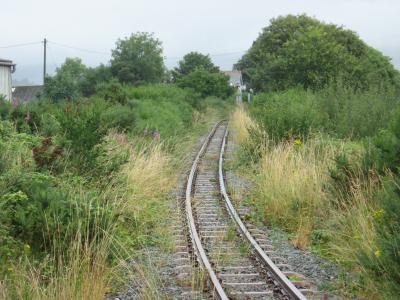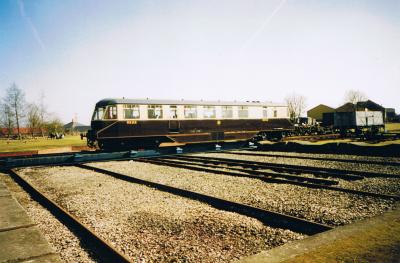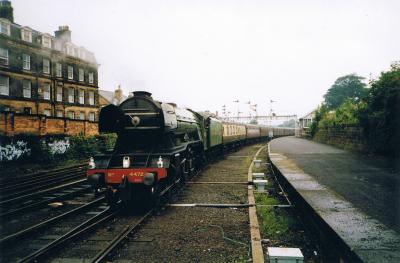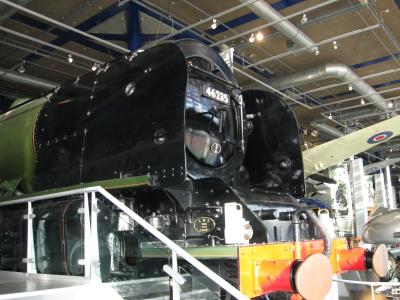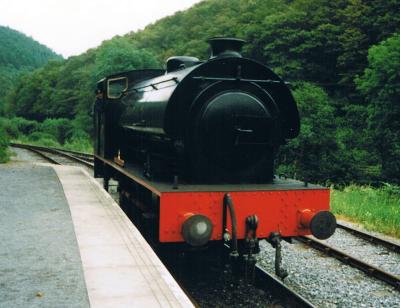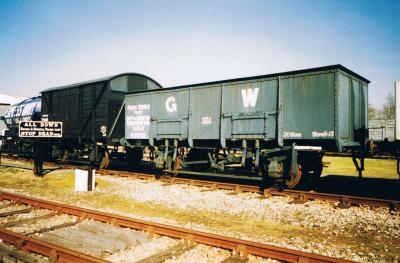|
|
||
|
|
||
|
The Railways Act 1921 appeared to envisage that the Grouping would cover all railway companies and would take place at the first second of 1923. This was not exactly the case. In fact, several mergers took place the previous year, with 1922 seeing the London and North Western and Lancashire and Yorkshire networks combine and begin an early re-organisation of management prior to full Grouping - a useful move given the ultimate size of their company. Meanwhile, the railways of Mid and South Wales were mostly coming under Great Western control 12 months early, with a couple of exceptions - principally the railway from Hereford to Swansea via Hay-on-Wye, which remained under London and North Western control and followed the company through the Grouping. Several other London and North Western lines in Wales passed to the Great Western. However, the Midland retained its share in the Midland and Great Northern Joint (Muddle and Get Nowhere) network in Norfolk along with its portions of the Severn and Wye network in the Forest of Dean and the Somerset and Dorset Railway from Bath to Bournemouth. The London and South Western kept its long tendrils in Cornwall for its Grouping company and the North British Railway retained its line to Mallaig - the most westerly in mainland Britain, despite its Grouping company having a name suggesting that its traffic was based in the North East of Britain. The resultant companies were known as the Big Four. The Great Western Railway was possibly the most harmonious of them, consisting almost entirely of the former Great Western Railway, although it included the Cambrian Railway, the Taff Vale, the Brecon and Merthyr, the Barry, the Alexandria Docks and Newport Railway (as the Pontypridd, Caerphilly and Newport had become), the Rhymney Railway, the Cardiff Railway and a few other odds and ends which it had forgotten to purchase before. Its main works was indisputably at Swindon and its London terminus was at Paddington. The London and North Eastern Railway, once inadvertantly spelt by the Germans as the London and East Northern Railway, consisted of the Great Northern Railway, the Great Central Railway, the Great Eastern Railway, the North Eastern Railway and the North British Railway. Each of these companies had fairly well defined boundaries and, for the most part, had kept out of each other's way. There were a few issues between them. The North Eastern had become very fond of electric locomotives under its locomotive superintendent Vincent Raven, and had built a fleet of 13 locos plus a large fleet of electric multiple units for suburban traffic around Newcastle. The Great Northern Railway preferred building steam locomotives at its workshops at Doncaster, where the new company's locomotive superintendent Nigel Gresley was showing great promise. He had just produced a new design of locomotive called the A1, and the third example, No. 1472 Flying Scotsman, was despatched to the Great Western for a trial of technology between the two companies (both ran fast trains on straight level track), which it lost. The LNER had to rebuild their pride with the first confirmed run at 100mph by a steam locomotive, although there was the irritating factor that the GWR claimed to have gone at 102.3mph with an inferior engine 30 years earlier in 1904. (This 100mph record has also been disputed and the first "safe" ton was actually acheived by Scotsman's classmate Papyrus a few months later, with a peak of 108mph.) The LNER made Doncaster its principal works and had London terminii at Marylebone, Kings Cross and Liverpool Street. The Southern Railway, the smallest of the four in terms of area of the country served, took on a sack of squabbling cats. With only short distances to cover between London and the South Coast ports the former companies of the South Eastern Railway, the London, Chatham and Dover Railway, the London, Brighton and South Coast Railway and the London and South Western Railway had all been able to have a wonderful time building competing railway lines and falling out. Each had a terrible reputation for comfort, speed and reliabilty and each was attempting to devise new ways of solving this when it wasn't falling out with its next-door neighbour. The LSWR and LB&SCR had both decided to experiment with electrification in 1913 - the former using a third rail and the latter using overhead wires. The Southern opted for third rail and began to spread it elsewhere, using electric trains to service the London commuter belt. In time honoured Southern fashion, the stock was rebuilt from the former loco-hauled coaches and retained the interior quality, which the company and its successors saw no need to upgrade. Memorably the Southern's three main suburban electric trains of the 1930s were the LAVs (train with lavatory), HALs (train where half the coaches have lavatories) and NOLs (no lavatory). The main works were at Ashford, Brighton and Eastleigh (near Southampton) and the company had London terminii at Waterloo, Charing Cross, London Bridge and Cannon Street. The London, Midland and Scottish Railway was one of the largest companies in the world and was the only one of the four to feature in England, Wales, Scotland and Northern Ireland. Swallowing up the London and North Western, the Midland, the Lancashire and Yorkshire, the Glasgow and South Western, the Caledonian and the Highland railways, it found itself with a network stretching from Bournemouth to Thurso and from Holyhead to Norwich (admittedly only reaching Bournemouth and Norwich by joint lines) and with all the rows associated with merging bitter rivals. The London and North Western had worked with the Caledonian to provide one Anglo-Scottish route and the Midland had worked with the Glasgow and South Western to provide another. The four companies met at Carlisle, where they had managed to share a station. It rapidly proved that they could not share a company, but eventually it was agreed that the LNWR would provide management while the Midland would organise locomotives and rolling stock. The LNWR therefore attempted to destroy the Midland by re-routing all its premier trains to the LNWR route, while the Midland continued to paint everything red and pursue its "small engine policy" where any train needing more than six driving wheels would be double-headed. This arrangement continues today, although since the 1960s the Midland has been forced to pay attention to the LNWR's ideas on locomotive size. The new company shared its construction work and management between Crewe and Derby and had London terminii at Euston, St Pancras, Broad Street and Fenchurch Street. Sixteen railways were left in the hands of Colonel Stephens, a sharp man who specialised in managing unprofitable railways at minimum losses. He purchased old locomotives from other organisations and ran them until they fell to bits. He acquired coaches which had been deemed unsuitable by three previous companies and used them until farmers wouldn't buy them for hen-houses. He purchased Ford motor-buses, fitted them with flanged wheels and ran them back-to-back as an early form of diesel multiple unit. His railways mostly survived until his death, whereupon his empire collapsed. Several closed almost immediately - principally the ones where it was quicker and more comfortable to use a donkey. In the South-east, the Southern kindly took the Kent and East Sussex Railway under its wing and it survived until 1964. In North Wales he owned the narrow-gauge Ffestiniog and Welsh Highland Railways, which were both dependant on the tourist trade to remain above water. The Ffestiniog bailed out the Welsh Highland with cross-subsidisation from its slate traffic for a while, before the Welsh Highland collapsed in 1937. |
||
|
||
|
Of the remaining independent railways, possibly the most notable were the Talyllyn and Corris lines in Mid-Wales, both with the theoretical gauge of 2ft 3inches. By the Grouping the Talyllyn had been in business for nearly 60 years and depended entirely on its original locomotive and rolling stock fleet (2 locos, 4 coaches, a large number of wagons and a brake van). It was owned by the local Liberal MP, which may have had something to do with its survival as an independent company. The Corris had just scrapped two of its locos to provide spares for the third and purchased a new loco to try to stay in business. It was not an easy life without the backing finance of a massive transport conglomerate. However, when the Corris found itself competing with local Great Western buses it rapidly realised that its solo career was over and it was bought out in 1930. Passenger services promptly ceased. The Talyllyn struggled on with its system for working locos of one on, one off - generally No.1 on and No.2 off. No.1 tended to ride better - it had more wheels after an unfortunate early period when the rear half of the loco was left to bounce up and down with no wheels to support it. Both locos had long fixed wheelbases (a bit like driving a car which you can't steer) and so had a tendancy to push the outer rail outwards on curves. The Permanent Way gang - what there was of one when it wasn't being employed to drive the trains - solved the problem by re-gauging the track to something more like 2ft 4inches in the knowledge that only two locos would ever use it anyway. Such was the way of working a minor railway through the 1930s. One additional minor railway was added to the network in 1925 in the form of the North Devon and Cornwall Junction Light Railway - a line from Torrington to Halwill Junction which connected two backwaters of the LSWR's Withered Arm network. With a maximum speed of 25 mph (in accordance with standard practice for light railways) and two passenger trains each way each day, it was an anachronism long before it opened and had it been built before the First World War it would have been lucky to reach the Grouping. Its wayside stations were mostly short, mossy and obscure platforms in sylvan areas, although Hatherleigh and Hole purported to offer some importance. Having missed the Grouping by two years, it remained independent until 1948 (though the Southern Railway agreed to operate it) and actually survived to be closed to passengers by Beeching; the northern part lasted for goods traffic until 1982, when it was regrettably dismantled and distant Barnstaple became the local railhead. The Big Four recovered slowly from the First World War and were just starting to get going again when in 1926 there was a General Strike, with practically every industry in the country walking out for more pay. Determined to run trains, the railways pulled in people off the streets, gave them maps and told them to drive the trains. Happily the strike only lasted 9 days - except in the mining areas, where it was eventually resolved when Winston Churchill sent the troops in to restore order a year later. Cheap labour was now a thing of the past and cost-cutting began in earnest. The Southern accelerated its electrification schemes and the third rail was soon rushing out of London across most of the network. The Great Western bought a diesel railcar from bus-builders AEC in Southall, London, and liked it so much they placed orders for more, eventually developing a fleet of 38 such vehicles. The LNER bought a railcar, thought about it, bought a couple more and then decided to extend the North Eastern Railway's electrification schemes to the Woodhead route between Sheffield and Manchester. War intervened and terminated the project. The LMS bought a fleet of diesel shunters from various designers, tweaked their ideas, bought some more, tweaked it further and went into mass production on what is now a rather familiar design which has only been altered a little since the 1930s. Class 08, as the current bog-standard design is known (the souped-up 27mph design is called Class 09), is either one of the world's best locomotive designs or merely working in an area where it seemed to work so nobody bothered to alter it. The only change since Class 08 appeared in 1952 has been the railway-wide move from vacuum to air brakes. |
||
|
||
|
The rising economy allowed the railways to take advantage of the tourist trade in summer. The LMS's ancestors had been running trains to Llandudno, Blackpool and Morecambe for years and the LMS continued this tradition. The LNER had Scarborough, Whitby and the East Anglian resorts of Skegness, Yarmouth, Clacton and Southend. The Southern had most of the South Coast and North Cornwall to play with, particularly Padstow, Bournemouth and Brighton, and the Great Western had the Cambrian Coast, South Wales, South and West Cornwall and North Devon - particularly Porthcawl, St Ives and Torquay. The Southern's Brighton Belle and Atlantic Coast Express services competed with the Great Western's Cornish Riveria to carry passengers to the beach. All four also experimented at various times with "camp coaches" where an old coach was positioned at a suitably quiet location (little seaside resorts, sylvan goods yards, the ends of freight-only branches) and people allowed to live there for a week during the summer. Every summer Saturday the railway would lay on every coach available to carry the crowds to the sand during a warm decade which even closed railways with buckled rails. For the rest of the week, the seaside towns would lie silent, their stations visited by little two-coach branch trains and the holiday stock idle in goods yards around the country. The LMS and LNER also soon found themselves back in a position where their railways were good enough to resume the Races to the North. The LNER had no need to worry about possible outcomes. LMS locomotive design in 1926 was no better than it had been in 1896. The Great Northern had booted the Singles which had done the honours the last time round off to a museum in the early 1900s and the LNER had now deployed their lovely new A1s on the workings. |
||
|
||
|
The LMS dug out their locomotive superintendent, Henry Fowler, and told him to design a larger version of his eponymous 4F - a six-wheeled goods engine based on a tried and tested (obsolete and undersized) Midland design which hauled trains all over the LMS network. Fowler busied away and had a look at other, similar designs used by other railways. He was particularly taken by the Great Western's Castle Class, one of which had beaten Flying Scotsman in the 1923 locomotive exchanges, but the Great Western refused to let him look at the drawings. The Southern was more co-operative, allowing him to prod at their "King Arthur" class locomotives, and a few months later Derby released 6100 Royal Scot - a very capable machine which soon found itself heading Anglo-Scottish trains. The pride and joy of these expresses was the 10:00 departure from Euston, also called the Royal Scot. The LMS was soon invited to demonstrate the pride of the British locomotive fleet in the United States, and so the LMS took 6100 into the works and swapped its identity with 6152 - a previously unimportant Glasgow-built example of the class which, thanks to this never-reversed swap, got six months holiday roaming the US with a demonstration train and was subsequently preserved. The fact that the original locomotive was not preserved was a shame, but as Crewe's rebuilding policy consisted of taking a locomotive to bits, scattering the bits around the works and allocating the number to a suitable set of bits which emerged from the works some months later, it can probably be said that the original 6152 had just as good a claim to be the class leader as the original 6100. Now the next step was streamlining. The current designs were all very well, but something more impressive was wanted. The LNER had been to Germany, where they had fast diesel railcars, and was determined to prove that steam could do better. The result was the Silver Jubilee train - a luxury express with a special set of coaches featuring a "Beavertail" observation car at the back and a wedge-shaped A4 locomotive at the front (presenting a world-famous design which now occasionally attracts complaints from people who think they are diesels). The doyenne of this highly-successful fleet debuted in 1935, painted in an impressive silver/grey livery (particularly impressive as it was generally clean) and named Silver Link. To show their belief in "any publicity is good publicity" they then allowed this magnificent beast to star alongside Will Hay in a film called Oh, Mr Porter! The LMS also developed a streamlined locomotive in response. This time they had the added benefit that they had "headhunted" one of Swindon's finest apprentices - William Stanier - to work as their locomotive superintendent at Crewe. Stanier had designed an incredibly imposing locomotive capable of dominating any scene - the "Princess Royal" class - which was introduced to take on the A1s in the early 1930s. Now the LMS wanted to improve it, so they put an upturned bathtub over the top of the design - much to Stanier's annoyance - which was then painted light blue with white go-faster stripes and called the "Princess Coronation" class. After some considerable moaning by the designer the bathtub was taken out of the design for the later-built locomotives (and subsequently removed from the original examples). The light-blue locomotives were used to haul light-blue coaches on the Coronation special train (which, lacking an observation car and looking remarkably like a rake of standard LMS coaches painted light blue with white go-faster stripes, was nothing to write home about) which then engaged itself trying to snatch world speed records off the LNER. Now, as world speed record rules stand for trains, the requirement is that the train must have achieved the speed claimed for it. The standard procedure, therefore, is to obtain a little assistance by finding a straight, steeply-graded section of track and run the train down it, preferably with a following wind. The Germans, not understanding that this was how the British were obtaining their records with inferior locomotives, tried to win glory for the Fuhrer by running their trains on the level, sometimes into a headwind, and got puzzled when the British beat them. The LNER had Stoke Bank, north of Peterborough - a long section of track which London-bound trains were taken down very fast when the LNER fancied posting a new world record. 100mph was raised to 110, then 111 and eventually 113. The LMS had longer, steeper stretches of track at Lickey, Shap and Beattock, but unfortunately they had sharp curves and busy stations at the bottom and so were unsuitable. Instead, they tried running their first streamlined locomotive, Coronation, down a gentle hill which led the Glasgow-bound express into Crewe. What resulted was more of a brake test and physics experiment than a speed record. Racing down the bank with a heavy train, Coronation was teetering on the edge of breaking the world speed record for a steam locomotive when Crewe station was sighted. Possibly reaching 114mph before the brakes came on, the locomotive sped through the approaches of the capital of the LNWR network with everyone hoping that it would stop in time. The train was routed into what was then platform 3, which had a rather convoluted approach involving several sharp crossovers. Coronation hit the first at 57mph (the normal speed for entering Crewe was then around 25), swayed, teetered, lurched and bounced towards the new line. There was the most almighty crash from the kitchen car. Riding the points and remarkably staying upright, the train swept into Crewe station and came to rest. An order was sent out for some new crockery. |
||
|
||
|
The LMS claimed its record, which is still debated, although it rapidly became academic as, soon after in 1936, German locomotive No.05002 achieved 124mph racing along a straight, flat length of railway in central Germany. Nigel Gresley decided he wouldn't stand for his locomotives not being top. He borrowed the newest, No.4468 Mallard, and arranged for it to go to the top of Stoke Bank on 3rd July, 1938 for a "brake test". Gresley, unfortunately, could not be there. However, with a dynamometer car to measure speeds, the best traincrew that could be obtained (brave driver, keen fireman, guard who normally worked 45mph goods trains) and a rake of coaches containing various engineers, Mallard trundled to the top of Stoke Bank, turned and prepared for the descent. At this point the people on board were told that there was going to be a record attempt and a taxi could be arranged to take them back to Peterborough if they wished. They stayed on board. Mallard departed and, sweeping down the bank, took the world speed record for steam traction of 126mph. Although 1mph faster than the current UK maximum, it was a one-off with a brand new locomotive. A warning stink-bomb suggested that part of the locomotive had overheated at this stage and Mallard was replaced at Peterborough, returning to Doncaster for an overhaul while a rather older locomotive of 1906 vintage took the train on to Kings Cross. Gresley was delighted and began drawing up plans for a 130mph run. Hitler, unable to stand the shame, decided to cheer himself up by invading Poland the following year. This had the added benefit that the ensuing world war reduced the UK speed limit for trains to 60mph, precluding any further record attempts until after the war, by which time Gresley was dead. Mallard's run was the grand finale of the 1930s extravaganza. It had seen Gresley's apprentice at Doncaster, Oliver Bullied, leave to design imposing air-smoothed express passenger "Merchant Navy" locomotives for the Southern, followed by a lighter version for lines west of Exeter called the "West Country". It had seen the Great Western try streamlining their locomotives by putting half a ball over a locomotive's smoke box door and smoothing the harsher lines of the design (an effect which sadly has not been replicated in preservation). Now it had seen the last flurry of steam-age development for something that was faster and sleeker. The only loco which stands any chance of beating Mallard's record is Darlington-built Tornado - and, appropriately enough, only if it goes to Germany. Once again the world was at war and once again the Government took over the railways and told them what to do. Apart from the maximum speed of 60mph, passenger trains were dramatically reduced and holiday traffic axed. Goods locomotives became a priority. Robert Riddles, one of Stanier's assistants, was seconded to the War Department and designed them some new locomotives. The larger "Austerity" locomotives consisted of a fleet of well over 1000 massive heavy-haul locomotives, all but four of which were eventually broken up (all of which fall into the small category of British locomotives in preservation which have never worked for BR - one went to Sweden and spent its working life there, being found stored in a forest in the 1970s, two came back from Greece and the fourth spent its life with the War Department). The smaller "Austerity" saddle tank locomotives were capable shunters with six wheels and a remarkably handsome appearance. Subsequently purchased as war surplus by anyone who could lay their hands on the things, these locomotives survived in industrial service into the 1980s and can be found at preserved railways all over the country. |
||
|
||
|
Oliver Bullied, meanwhile, was determined to show off his engineering genius. His request to build more "West Countries" was denied because they counted as express passenger locomotives. By shrinking the driving wheel diameter by six inches he slipped them through as mixed traffic machines and the airsmoothed and distinctly '30s "Battle of Britain" class was duly built in suitably large numbers. He also designed a fleet of general goods engines called the Q1s, for which he removed all surplus parts, leaving a very odd looking locomotive with no side frames and very oddly designed boiler cladding. The result was indescribable. His contemporaries on the other railways were very rude about it. It was sarcastically suggested that the boiler shape, consisting of three blocks with the largest at the cab end and the smallest around the smokebox, was intended to allow the locomotive to be slid into itself so that more locomotives could be fitted into the sidings. The Q1 was a great success but only one has been preserved. Meanwhile the railways bore the brunt of the war. The Dunkirk evacuations saw all spare stock from all over the network despatched to the South-east coast of England to move the troops inland. With the need to build up good defences around the area the intensive commuter network was invaluable, even if it saw far fewer commuter trains. Bombing raids destroyed the glories of the LNWR's Birmingham New Street station - it would never recover its architectural power. St Pancras and Kings Cross had vast holes blown in their roofs (part of the damage at Kings Cross was only repaired in the last few years; the LNER just rebuilt the shell of the office building involved but neglected to refit it). A munitions train in Norfolk caught fire while passing through the town of Soham but a mixture of luck, skill and bravery got the loco and burning wagons out of the town before the load exploded, killing the driver. York shed took a direct hit one night when one of Mallard's classmates - an unnoted A4 called Sir Ralph Wedgewood - had accidentally ended up spending the night there. The loco was destroyed instantly. A memorial plaque still rests in the floor of the shed, now used as the National Railway Museum. It was the closest Hitler got to revenge for Mallard's record. The Southern lost a large number of electric trains, along with an elderly locomotive called Victoria which was attacked out of a clear blue sky by a Luftwaffe fighter plane, which sprayed the old engine with bullets. As it passed overhead the locomotive's boiler exploded, causing the plane to crash in a nearby field and kill the pilot. When it came to D-Day the railways carried the loads to the ports for despatch to France and continued to deliver equipment and munitions. By the time peace was declared in 1945 the railways were dead. Black locomotives heaved heavy trains around a decrepit network and once proud stations lay ruined. Work began on rebuilding as the new Labour Government proudly announced that the railways had worked so well that they were going to nationalise them. It was cheaper than paying them for all their hard work. It would prove to be the beginning of a long decline for the network. |
||
|
||
|
As Labour announced its plans to nationalise the railways the Big Four began work on modernising again. The Great Western ordered another hundred pannier tanks and 50 Castles. The LNER began electrifying the Woodhead route and briefly lent the trial locomotive, built just before the war and never used, to the Dutch. They called it Tommy. Gresley's death had left his generally unpopular assistant Edward Thompson in charge of locomotive design. Thompson rebuilt Gresley's prototype A1 into a prototype for his own locomotives. The rest of the A1s underwent less extensive rebuilds and emerged as A3s. Thompson's developments turned into the A2s, before his 1946 departure saw him replaced by Arthur Peppercorn, who designed a new and better fleet of A1s. Bullied was asked to design a locomotive to replace the oldest members of the Southern's locomotive fleet, as over half of their steam engines were distinctly pre-Grouping and had worked the network next to Europe through two World Wars. He started with the Q1 (which was what his boss envisaged a development of), made it look a bit like a "West Country", made it lighter, shifted the boiler to the middle and put a cab at each end, put a casing over the whole lot so it looked like a diesel and then provided a corridor so the heavy boiler was off-centre and the locomotive needed extra weights to make it balance. He called it "Leader". Five prototypes were ordered. One was finished. The Southern and Bullied didn't last long enough to see the project through. "Leader" had certain reliability issues and was distinctly temperamental. The new company ordered more "West Countries" and used those on the two-coach branchline trains instead. This created the strange oddity that the engine was almost as long as the train it was hauling. Most of the pre-Grouping locomotives survived into the 1960s, the "Withered Arm" ex-LSWR network west of Exeter continued to be largely worked by ex-LSWR machines and pre-Grouping Southern companies are remarkably well represented in preservation. Meanwhile the Southern also ordered three new electric and three new diesel locomotives, all of which left a little to be desired on the design front. The LMS also ordered three diesels - two big ones and a little one. It was the LMS which won the race and in December 1947 LMS No.10000 became the first mainline diesel locomotive to operate in Britain, its vast black bulbous noses gazing down on its onlookers. You will never have a chance to appreciate it properly. In the biggest loss to posterity since the first railway engine, it was scrapped in 1968. Two railways escaped nationalisation despite some trains still operating, although in both cases you could be forgiven for thinking otherwise. The Ffestiniog Railway mostly shut in 1946. The first loco to haul a train up the line - No.1 Princess - hauled the last one down on the 2nd of August 1946. The following day the staff were abruptly sacked and no trains ran on the mainline for 8 years, although some sidings at the upper end of the route in Blaenau Ffestiniog saw the odd wagon movement into the 1950s. The Talyllyn Railway struggled through 1947 and into 1948 as an independent concern still owned by the local MP, with No.1 finally set aside in 1946 and No.2 overhauled to handle the remaining two trains per day, three days per week. British Rail, as it was to be, offered a bright future. Yet it also marked the point at which railway history split into two - the independent lines, looking back at history and forward at how they might reflect that history in the future, and the main network, mostly looking down at the bottom line. That tended to be looking down too. So for the next bit there are two articles. Take your pick: |
||
|
|
||
| Introduction from a series of articles in The Railway Magazine on the Big Four; races from the same magazine's Quest for Speed feature in July 1998; Talyllyn Railway information from Railway Adventure by Tom Rolt; railcars from Great Western Diesel Railcars by Colin Judge; Bullied stuff from Leader: Steam's Last Chance by Kevin Robertson; Royal Scots from David Jenkinson's book The Power of the Royal Scots. Other information drawn from other sources of a miscellaneous nature. |
|
|
|
